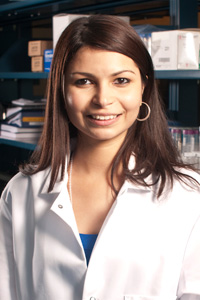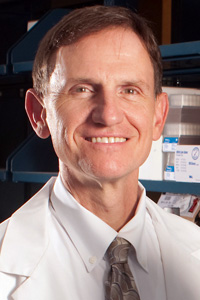Cancer researchers make important strides toward creation of artifical salivary glands


Researchers at the Center for Translational Cancer Research at the Helen F. Graham Cancer Center are making important strides toward the creation of artificial salivary glands, a breakthrough that will ultimately provide relief for thousands of patients who can no longer produce saliva as a result of radiation treatment for upper-respiratory cancer.
Robert Witt, M.D., chief of the Multidisciplinary Head and Neck Oncology Center at the Graham Cancer Center, and Swati Pradhan Bhatt, Ph.D., a post-doctoral fellow at University of Delaware, are working on ways to grow cells taken from patients before radiation on a 3-D biomaterial-based scaffold that will mimic salivary gland functions.
“The scaffold allows cells to grow more the way they do in a real human environment,” Dr. Witt says.

In recent years, researchers have made significant progress in engineering cartilage, bone and bladder tissue. Recently, doctors in Sweden implanted a laboratory-made windpipe that contained the patient’s own cells into a man with late-stage tracheal cancer.
“Those structures are less complicated than glands,” Dr. Witt says. “We have further to go to get to the place where the cells can perform their function.”
The Center for Translational Cancer Research is a vibrant partnership between Christiana Care’s Helen F. Graham Cancer Center, the University of Delaware, A.I. duPont Hospital for Children/Nemours, and the Delaware Biotechnology Institute, who share a common vision to improve cancer research and delivery.
“Dr. Witt’s project in collaboration with Dr. Bhatt is an example of the type of cutting-edge translational cancer research that is ongoing at the Center for Translational Cancer Research,” says Nicholas Petrelli, M.D., medical director of the Helen F. Graham Cancer Center. “Bringing clinicians together with scientists is the key to new cancer treatments and prevention. The Center for Translational Cancer Research is also an environment that allows students and residents to learn the techniques of cancer research with a better understanding of cancer biology.”
The salivary spheres engineered in the project at the Center for Translational Cancer Research can form lumens, essentially the inside spaces of a tubular structure, such as the ducts that water passes through in salivary glands.
“Lumen formation is important because we need a place for the saliva to be secreted,” Dr. Bhatt says.
The next step is to deliver growth factors that will enable the cells to branch out and cover the entire scaffold so that they will be able to secrete abundant protein and fluid.
Dr. Witt says it could be 10 years or more before artificial salivary glands are implanted in patients. The procedure will offer a sweeping improvement in quality of life for the 40,000 patients each year in the United States who develop xerostomia—an abnormal dryness of the mouth—after radiation treatment. Without saliva, patients have difficulty swallowing. They are vulnerable to tooth decay. They often lose weight and are undernourished.
“They don’t eat well because food doesn’t taste good,” Dr. Witt says. Currently, medications provide little relief. “The patients carry a water bottle. That’s the treatment.”
What researchers learn in developing salivary glands also could benefit work on other glands, such as the prostate, mammary and thyroid.
“Tissue engineering/regenerative medicine is an exciting, emerging approach in modern medicine, as it involves the delivery of living tissue,” Dr. Bhatt says. “The scope is so wide, and this project has much promise.”